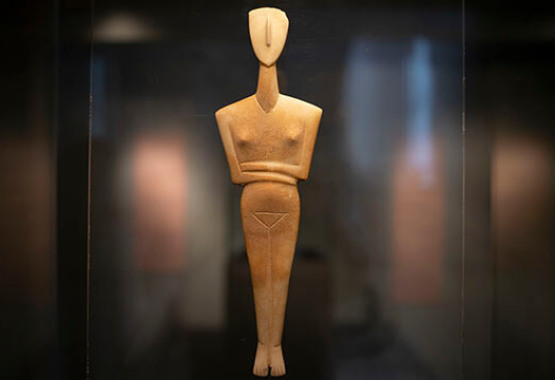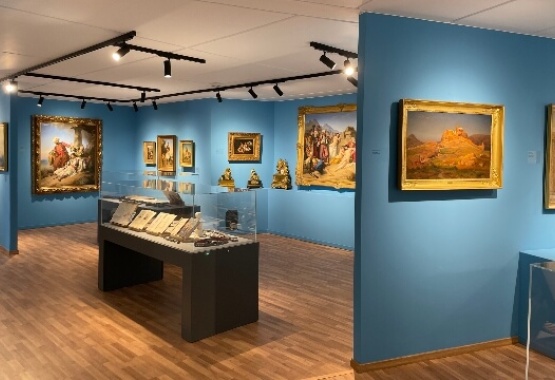
ATHENS
The museum and its collections cover 2500 years of Greek history and consist of a complex of six acres of buildings, courtyards and gardens, thus offering a panorama of Greece, past and present. It consists of two parts: the folk art section - “Pyrgi” - formerly the home of Ian Vorres, and the museum of contemporary Greek art.
In 1962, when Ian Vorres returned to Athens from Canada after an absence of 20 years, he was shocked to witness the urbanization of post-war Greece. So he decided to do something to save and promote a genuine Greek environment. He bought an area of 2 acres in the quaint town of Paiania, the birthplace of antiquity’s orator Demosthenes which contained 3 abandoned early 19th century homes and folkloric elements. It was there, that he decided to make his home and realize his personal vision of the subtle, graceful elegance and beauty of traditional Greece in all its architectural and decorative variations.
Pyrgi features rare furniture, peasant carpets, village troughs, jars, millstones, wrought iron, icons, engravings, an important collection of ceramics, paintings and prints pertaining to the early history of modern Greece, important antiquities, as well as popular artefacts’ and objects formerly used in daily Greek life, readapted so as to reveal their inherent beauty and their practical use.
The gardens, an indispensable part of Pyrgi and feature the best that the Mediterranean flora has to offer, have also been enriched with numerous antique and popular artifacts.
“A home’s essence lies in its permanence” H.L. Mencken once said. The essence of Pyrgi is the permanence of the Greek spirit throughout the ages.
In the early 70’s, Ian Vorres’ collective interest extended to contemporary Greek art. Though the fury of World War II literally devastated Greece from end to end, Greek art, like a phoenix rising from its ashes, rallied and recovered in no time, entering a period of astounding flourish. New ideas, new forces, new initiatives, mark this post-war period, confirming the popular belief that Greece never really dies.
It is exactly this singular achievement of Greece’s artistic potential covering the second half of the 20th century that is featured in the Vorres Museum collection of paintings and sculptures, which is considered the largest and most representative of its kind in the world. The building housing this collection has been designed by leading architect Michalis Photiadis.
In 1983, Ian Vorres donated his entire collection to the Greek nation in the form of a cultural non-for-profit foundation called “Vorres Museum”. The museum receives an average of 15.000-20.000 visitors per year, including heads of state, foreign dignitaries, international personalities, high ranking government officials, and of course numerous students.
Vorres Museum
It has been said that each adventure is a hidden aesthetic experience. This fully applies to the creation of the Vorres Museum, a life-time effort and adventure of its creator, Ian Vorres.The museum and its collections cover 2500 years of Greek history and consist of a complex of six acres of buildings, courtyards and gardens, thus offering a panorama of Greece, past and present. It consists of two parts: the folk art section - “Pyrgi” - formerly the home of Ian Vorres, and the museum of contemporary Greek art.
In 1962, when Ian Vorres returned to Athens from Canada after an absence of 20 years, he was shocked to witness the urbanization of post-war Greece. So he decided to do something to save and promote a genuine Greek environment. He bought an area of 2 acres in the quaint town of Paiania, the birthplace of antiquity’s orator Demosthenes which contained 3 abandoned early 19th century homes and folkloric elements. It was there, that he decided to make his home and realize his personal vision of the subtle, graceful elegance and beauty of traditional Greece in all its architectural and decorative variations.
Pyrgi features rare furniture, peasant carpets, village troughs, jars, millstones, wrought iron, icons, engravings, an important collection of ceramics, paintings and prints pertaining to the early history of modern Greece, important antiquities, as well as popular artefacts’ and objects formerly used in daily Greek life, readapted so as to reveal their inherent beauty and their practical use.
The gardens, an indispensable part of Pyrgi and feature the best that the Mediterranean flora has to offer, have also been enriched with numerous antique and popular artifacts.
“A home’s essence lies in its permanence” H.L. Mencken once said. The essence of Pyrgi is the permanence of the Greek spirit throughout the ages.
In the early 70’s, Ian Vorres’ collective interest extended to contemporary Greek art. Though the fury of World War II literally devastated Greece from end to end, Greek art, like a phoenix rising from its ashes, rallied and recovered in no time, entering a period of astounding flourish. New ideas, new forces, new initiatives, mark this post-war period, confirming the popular belief that Greece never really dies.
It is exactly this singular achievement of Greece’s artistic potential covering the second half of the 20th century that is featured in the Vorres Museum collection of paintings and sculptures, which is considered the largest and most representative of its kind in the world. The building housing this collection has been designed by leading architect Michalis Photiadis.
In 1983, Ian Vorres donated his entire collection to the Greek nation in the form of a cultural non-for-profit foundation called “Vorres Museum”. The museum receives an average of 15.000-20.000 visitors per year, including heads of state, foreign dignitaries, international personalities, high ranking government officials, and of course numerous students.




